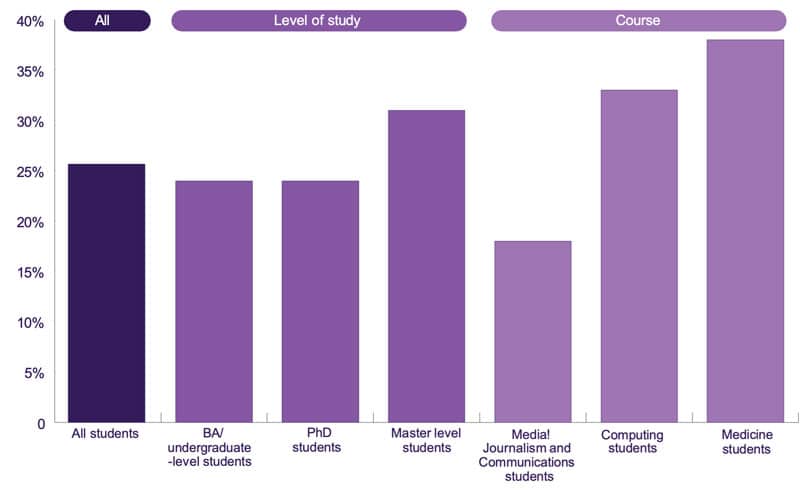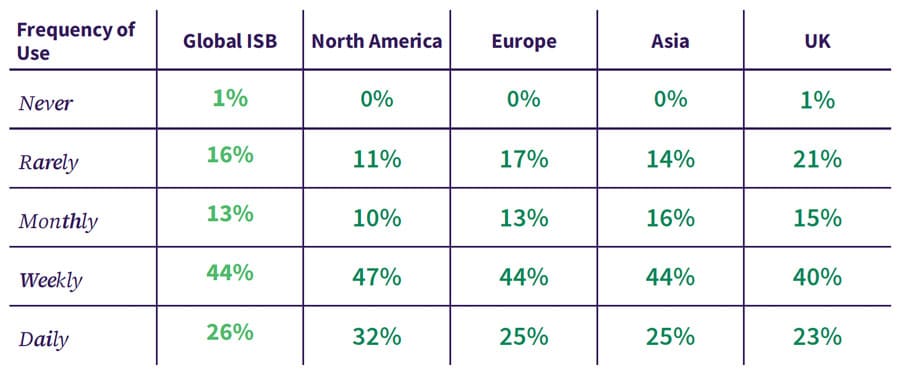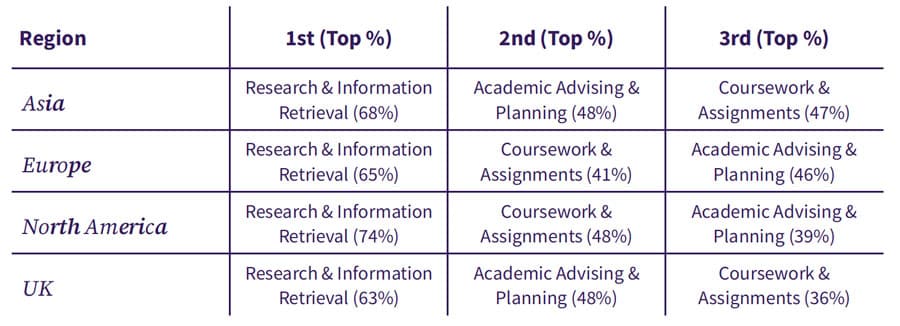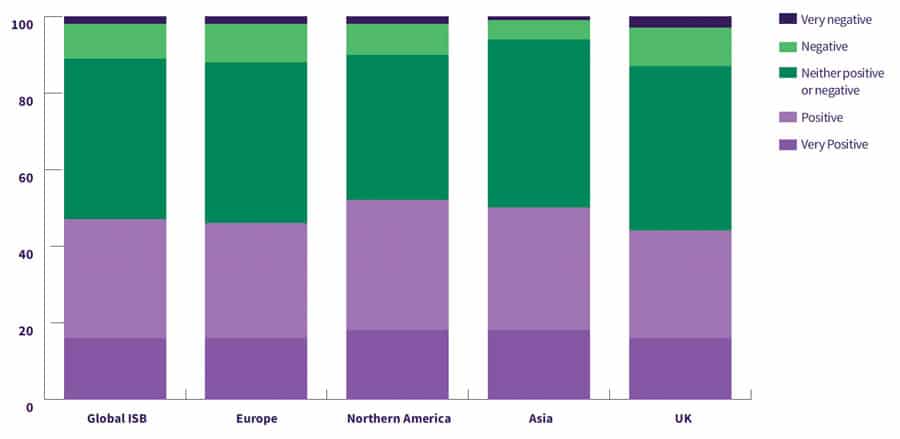How does this current generation of students view the impact of AI?
The following is a guest post contributed by Nannette Ripmeester, the Regional Director for Europe and North America at Etio. Among many other industry initiatives, Etio produces the International Student Barometer, the world’s largest international student experience survey of enrolled students.
Artificial Intelligence (AI) has introduced new elements in the way students learn and work. Understanding how students perceive and interact with AI can help higher education institutions make informed decisions about whether and how to incorporate AI tools into curricula and support services.
Since 2024, the International Student Barometer (ISB) has expanded its learning satisfaction questions to include insights into how AI is currently integrated into educational settings, as well as into its perceived impact on students' learning journeys and future career prospects. In this article, we will look at some global trends based on the International Student Barometer (ISB) data gathered from over 106,000 students, but we will also pay attention to regional nuances revealing important differences in how students engage with these emerging technologies.
The ISB data gathers responses on AI spanning six main areas:
- Usage
- Overall satisfaction
- Learning experience
- Frequency
- Areas of use
- Impact
AI usage among student populations

Identifying whether students are relying on AI-based tools or technologies to assist their studies helps institutions gauge the current levels of usage. Globally 57% of enrolled students mention they use AI tools, with a significantly higher proportion of international students studying at European institutions acknowledging they use AI (74%) than international students studying in Asia (65%).
26% of students mention they use AI tools daily, with Master level students using AI tools the most (3l% using it daily against 24% of both BA/undergraduate-level students and PhD candidates). When we look at study area, not surprisingly, Computing students are among the ones that use AI tools most frequently (33% daily use). Medicine students, with 38% stating they use AI tools daily, are among the top users, whereas only l8% of Media, Journalism, and Communications students claim they use it daily.
Overall satisfaction with AI integration
The ISB also measures students' overall satisfaction with how AI technologies are integrated into their learning environment. This metric helps institutions understand whether their digital strategies meet student expectations or if adjustments and further integration are needed to enhance the study experience.
ISB data shows the highest satisfaction with online learning in Asia (65%). This might suggest that Asian institutions may be further along in adopting digital tools into their curricula, while regions with a lower satisfaction (e.g., the UK, which scores 47%) might hint at a stronger tradition of campus-centered education. When we look at the differences in satisfaction with online learning tools, we see that overall students are happiest with online learning resources and library facilities, an area where North American, European, and UK institutions outperform Asian institutions.
Impact on learning experience
Students are extremely positive about the impact of AI-based tools on their learning experience. We see a very high level of satisfaction globally of 94% (taking strongly agree (34%) and agree (60%) responses together), with North American institutions topping it with 96% of international students saying they strongly agree (42%) or agree (54%) that integrating AI technologies into their institution experience has positively enhanced their learning experience. Institutions in Asia also score 96% here but the percentage of international students saying they strongly agree is much lower (3l%).
This type of information will enable institutions to assess whether students view AI as an asset or as a challenge, guiding decisions on embracing AI-driven learning tools more actively or prioritising different methods. Despite differences in modality preference, the overriding insight is that (international) students across all regions overwhelmingly seem to recognise the value AI brings.
Frequency of AI usage by region (destination)
Understanding how often students use AI tools complements insights into students' learning patterns and helps locate the role of AI in their education. Only 1% of international students surveyed in the ISB 2024 claim they never use AI tools, whereas 26% state they use AI tools on a daily basis.
Looking at regional breakdowns, it is interesting to notice that international students at North American institutions lead in daily interactions (32%) as well as weekly use (47%), possibly driven by the integration of AI tools in learning systems. It leads us to ask the question: Does higher daily usage correlate with stronger perceptions of AI's usefulness?

"Today's students, particularly younger generations, interact with AI intuitively in their everyday lives, often without even realising it. To meet their evolving expectations, institutional departments (marketing, admissions, academics, career advisors, alumni relations, etc.) must align around a unified, student-centered experience. ln this context, AI becomes the connective tissue that enables immediacy, personalisation, and predictive insight at scale," says Alejandra Otero, founder and CEO of geNEOus, enrolment management experts. With student expectations rising and attention spans shrinking, we need student satisfaction data helping us balance human emotional intelligence with the enhanced efficiency AI makes possible.
Areas of use
The ISB also explores the specific domains in which AI tools might have had the most significant impact, including:
- Academic advising and planning
- Communication with lecturers and peers
- Coursework and assignments
- Research and information retrieval
- Time management and organisation
Identifying the areas where AI makes the greatest difference helps institutions make informed decisions on how to tailor their support and development strategies to best meet students' needs.
Across all regions, students concentrate their AI use in three top domains, with research and information retrieval as the most used domain:

Perceived impact on future careers
We have also asked students a question around the impact of AI on their future career prospects. This is an important question to address. Understanding whether students view AI as an enabling or hindering factor to their careers can help institutions better prepare their students for an AI-integrated workforce. For instance, the chart below visualises students' perceptions from various regions on how AI may affect their career prospects. The majority of students remain neutral about AI's impact on their career prospects, while a substantial percentage of students globally view it positively. Negative perceptions are relatively low (only 11% globally), suggesting that students are generally optimistic about AI's influence in determining their professional future.

Interestingly, we observe a general convergence on how students perceive AI's impact. Despite some fluctuations between regions, the overall sentiment remains consistent, revealing a shared sense of cautious optimism or neutrality across various parts of the world when it comes to the impact of AI on careers. While the global story of AI-based tools in education is one of near-universal enthusiasm (94.5% positive), regional patterns remind us that modality preference, daily engagement, and application priorities differ. Irrespective of how we view the use of AI in higher education, the ISB data helps us to make decisions: Do we want to fortify digital classrooms, deepen tool integration, or respect the value of in-person learning? Notwithstanding the choices we make as educators, we need to understand how currently enrolled (and future) students view AI-based support in learning.
















